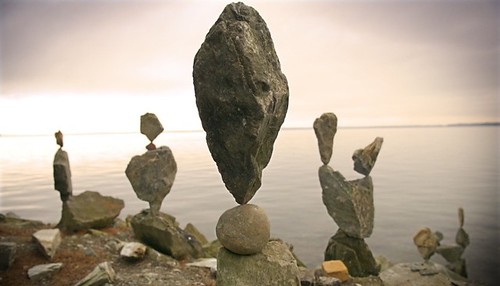Monday 30 November 2009
Elizabeth Gilbert on nurturing creativity
Elizabeth Gilbert faced down a premidlife crisis by doing what we all secretly dream of – running off for a year. Her travels through Italy, India and Indonesia resulted in the megabestselling and deeply beloved memoir Eat, Pray, Love, about her process of finding herself by leaving home.
Selected quotes:
''Being a genius instead of having a genius'' - refering to point in time were peoples beliefs changed. Instead of genius coming from without, from a higher source it now came from within.
Does school kill creativity?
Why don't we get the best out of people? Sir Ken Robinson argues that it's because we've been educated to become good workers, rather than creative thinkers. Students with restless minds and bodies -- far from being cultivated for their energy and curiosity -- are ignored or even stigmatized, with terrible consequences. "We are educating people out of their creativity," Robinson says. It's a message with deep resonance. Robinson's TEDTalk has been distributed widely around the Web since its release in June 2006. The most popular words framing blog posts on his talk? "Everyone should watch this."
A visionary cultural leader, Sir Ken led the British government's 1998 advisory committee on creative and cultural education, a massive inquiry into the significance of creativity in the educational system and the economy, and was knighted in 2003 for his achievements. His latest book, The Element: How Finding Your Passion Changes Everything, a deep look at human creativity and education, was published in January 2009.
Selected quotes:
''creativity is as important as literacy''
''If your not prepared to be wrong you will never come up with anything original''
''All children are born artists, the problem is to remain an artist as we grow up''
''We dont grow into creativity we grow out of it, or rather we are educated out of it''
''They (professors) look upon there bodies as a form of transport for there heads''
''Creativity: the process of having original ideas that have value''
''If all the insects were to disappear in 60 years there would be no life on earth.
If humans were to disappear in 60 years all life on earth would be flourishing''
Liz Coleman on present day education
If you followed higher education news in the 1990s, you have an opinion on Liz Coleman. The president of what was once the most expensive college in America, Coleman made a radical, controversial plan to snap the college out of a budget and mission slump -- by ending the tenure system, abolishing academic divisions and yes, firing a lot of professors. It was not a period without drama. But fifteen years on, it appears that the move has paid off. Bennington's emphasis on cross-disciplinary, hands-on learning has attracted capacity classes to the small college, and has built a vibrant environment for a new kind of learning.
Coleman's idea is that higher education is an active pursuit -- a performing art. Her vision calls for lots of one-on-one interactions between professor and student, deep engagement with primary sources, highly individual majors, and the destruction of the traditional academic department. It's a lofty goal that takes plenty of hard work to keep on course.
Selected Quotes:
What kind of a world should we be making?
What kind of a world can we be making?''
''When the impulse is to change the world, the academy is more likely to engender a learned helplessness than to create a sense of empowerment''
''No one has the answers
Everyone has the responsibility''
''History provides a laboratory in which to see
the actual as well as the intended consequences of ideas''
Karla Black
Karla Black often asks herself what she would make if there were no other people in the world. In all likelihood, she imagines, she would become obsessed with beauty, producing colourful, tactile and aesthetically indulgent creations, but the chances are that, as art, these objects wouldn’t be very interesting. She is also aware that, making art in a crowded world, she risks running too far in the opposite direction – of becoming over-conscious of others, even deferential in her acknowledgment of precedents and peers, of histories, trends and expectations. Black knows that in order for her art to engage with its audience it must engage in a tussle between action and reaction, between making things for oneself and making for the benefit of others. She has even gone so far as to say that ultimately her art, perhaps all art, is actually just a series of compromises.





Saturday 28 November 2009
Nick Savvas
A room full of 50,000 floating, coloured balls arouses some odd responses in people.
"When it showed in Melbourne, I had this guy who came in and sat in front of the work for two hours. Then he came back and did it again the next day and the day after that," said Nike Savvas, whose art work Atomic: Full of Love, Full of Wonder was installed at the Art Gallery of NSW yesterday.
The spray-painted balls, attached to strings of fishing line, vibrate when wall-mounted fans are switched on, and took 10 days to install.
Savvas, 42, said she was partly inspired by the French artist George Seurat, who covered his canvas in tiny dots to create landscapes, but also admitted homesickness was an influence.
"I live in London now. I come back every year, but I get desperately nostalgic for the Australian landscape," she said, explaining that the colours are layered to represent the sky and red sand. "The shimmer it takes on when it vibrates is a bit like … heat haze. The further back you stand, the more you see it."
Savvas was among eight artists featured in the gallery's new sculpture exhibition, Adventures with Form in Space. Also on show is Jonathon Jones's 28-metre-long iceberg constructed by Damiano Bertoli, and Hany Armanious's flowing black lines of gaffer tape which are stuck on the walls.
The exhibition's curator, Wayne Tunnicliffe, said he wanted to broaden the definition of sculpture. "It's just not a statue of a man on a plinth," he said, adding that the exhibition title suggested fun. "It's saying 'come along for an adventure', which means … experimenting and trying new things."


Friday 27 November 2009
''Noticings'' the game of noticing things around you
What are noticings?
Noticings are interesting things that you stumble across when out and about.
For example: perplexing pavement markings, a discarded photo, and a ceramic space invader are all noticings.
Players are awarded points for things like spotting the first thing in a neighbourhood, or noticing something every day for a week.
How to play
You play Noticings by uploading your photos to Flickr, tagged with 'noticings' and geotagged with where they were taken. We've got a page with the rules and some instructions to help you out.
Each turn is a day, and at 3pm GMT every day photos from the previous day are imported from Flickr and the scores calculated.
Noticings aren't very transient things, like people, and you should only take one photo of each thing you spot. If in doubt, explore other people's noticings to get the idea.
Quotes from Today

''All greatness stands
firm in the storm''
''Think as I think'', said a man,
''Or you are abominably wicked;
You are a toad.''
And after I had thought of it,
I said, '' I will, then, be a toad.''
Stephen Crane - "Think as I think," said a man
''Everything has its beauty but not everyone sees it.''
- Confucius
Chinese philosopher & reformer (551 BC - 479 BC)
Magic Moments

I love when really beautiful moments like this come in to my life. Grace had asked me to help her take some pictures for her cross school project. She had described briefly to me her idea but in my mind I had a different image to how things actually turned out. It was such a simple idea but so so beautiful. The candles were placed inside the holes in the tiled wall and they created this amazing line pattern of light, the lighting was perfect, just between light and dark. I had been talking with Grace before this about how artists see things that others would normally walk by, and how this was a real gift to have. This was a perfect example of such ''seeing'', taking something every day and ordinary and turning it into something extraordinary.
Thank you Grace :)





Shane Hart
Upala Yoga Stone Sculpture
The art and practice of stone balancing has been cultivated around the world for thousands of years. It’s known by names such as Land Art, Awareness Art, Petromancy and Earthworks. I call it Upala Yoga (Stone Yoga). Upala and Yoga are Sanskrit words; Upala means stone and Yoga means union. Upala Yoga is temporal, hours can be spent on a sculpture and a subtle vibration or light wind can take it down in an instant. It’s a meditative art that evokes a sense of amazement, focuses our attention in the moment, and challenges us to examine our attachment to the material world.
Shane Hart
I began working with balanced stones in 1995. The seeming impossibility of it is what drew me in, and I’m still amazed when I slowly pull my hands away from a stone and it remains there defying gravity. As a child I was fascinated with magic tricks and illusions, and as I grew older my fascination with the implausible led me to explore martial arts, yoga and meditation. It’s these experiences I draw from and integrate into the art. While living in San Diego most of my stone balancing was done at Cardiff by the Sea along highway 101. In 2003 I moved with my family to Bellingham WA, occasionally constructing stone sculptures during excursions into the Mt. Baker area and along local hiking trails. In January of 2007 I was playing with my children and balancing stones at a city park, to my surprise an enthusiastic crowd formed. It was the warmth and strength of this response that’s led to installations and public works.
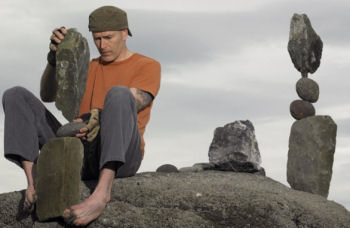
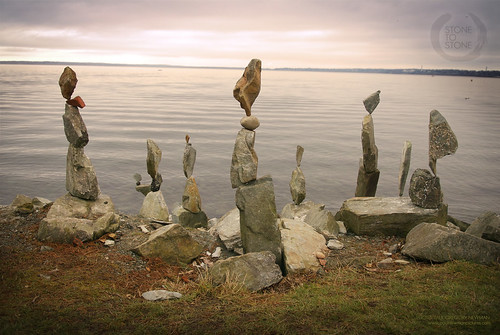
Lava Sculptures


Playing around with some lava rocks that I brought back from Sicily. I really love working with natural stone like this, it has a special kind of energy that you dont get with man made materials. It is fascinating to think it has came from deep in the earth. Its one of my goals to back to Sicily and work with the lava on a larger scale, stacking the stones up like this, seeing how high I can go. This is a few pictures I took of the volcano when I climbed it in Sicily.




Thursday 26 November 2009
Ricky Swallow
From http://rickyswallow.com/texts/view/lesley-vance-talks-to-ricky-swallow/
''People are surprised when they find out other animals in the kingdom express loyalty, for example. We’re just dolphins with expensive jumpers.''
''It’s overly romantic, but there is some kind of emotional struggle to make anything in the studio work. If I think something is really moving, I want everyone that’s close to me to have experienced the same thing—like if I went to a concert I really like, or when I saw the film Nashville. So, just this idea that there is the ability to move people . . . I feel like it used to happen with art a lot more before art had to compete with a lot of other things. When art was the movies and television. . . . I think music sticks, and I don’t think artworks stick in the same way. Having every Neil Young album is kind of like having access to a whole series of narratives that you’re not involved in, but you can somehow get involved in through the music. Studio soundtrack is a very long question. It’s something about a lasting impression and the sculptures are supposed to be a lasting impression of something else.''
LV: I want to talk about the nature of wood, the material. RS: One of the embarrassing things I have to tell people when they ask me what I do is that I’m a wood-carver. And then there is this question: How can I tell people I carve things out of wood without them thinking I should be arrested? It’s the stuff of wizards and unicorns. I’m talking about traditional wood carving versus what I do. I’m proud of how traditional it is and how handmade it is, and one of the things I think is important is that one goes to the studio and actually makes things. But, to be a wood-carver is sort of returning to something old. And since I haven’t been using plastics and sanding, I feel like it’s almost a more wholesome studio. I guess it’s also an acoustic material. It’s a living material—like it still moves when it’s taken off the tree. Although you try to plan for as little movement as possible, it still has the ability to expand or shrink. When I chose that wood I was looking for another material that was as mute as the cardboard or the white PVC—something that doesn’t have a purpose. Like the only purpose it has is its subject. It’s about description and abbreviation. But if the material itself is abbreviated then it’s kind of invisible. It’s one of the most unwooden woods you can find. LV: But it’s still wood. It’s a lot like flesh. RS: It’s a very bodily material. That wood is traditionally used for pattern making, and conceptually it interested me that its major use was to show people what a thing could look like—to suggest an idea rather than to structurally improve somebody’s house. It literally has this function that it’s not quite at a “real world” level of finish. It’s the material of a proposal. You know, regarding empathy, I don’t think these things would have the same effect if they weren’t done in wood. I think the kind of material you use definitely affects what you make in that subject. It just causes you to look at things in a different way. Things appear to me now that I want to carve. They appeal to me both because I’m conceptually interested in what they could do with something else, but also because I wonder how they would be, or how much stranger they would get if they were sculpted in wood. In more of the recent things, like, say, the table, there’s one large slab of wood representing twenty different kinds of materials to unify the description into one experience. There’s not the distraction of details in terms of surface renderings. And I hope that’s what makes the experience of them more intimate, because you’re in the “beige zone.”
RS: I’m someone who thinks about, “Okay, it’s mid-February. What was I doing a year ago or what have I done in the year since last February?” I’m in L.A. now, and I was here five months ago. What have I achieved in terms of productivity in the time since visits here? I keep studio logbooks of hours, even though I don’t pay myself an hourly rate. And now I’m just as particular about these books as I am about these pens that I got in Japan. And it’s because it’s there to remind me. . . . It’s interesting to answer the dumbest question in the world, like: “How long did it take you to make this sculpture?” And I can say “464,000 hours.” But it’s also that at the end of the day I need to see the number “12” at the end of the page, and if it’s not there I feel like I’ve ripped off the project. I am kind of nerdy about that. My dad talks about having a fishing logbook, and he questions the legitimacy of my birth date, because according to his fishing log, he had to fly back from Tasmania because mom was in labor with me. I was born a day early or a day late of my actual birth date. So he thinks it was just a mistake on the birth certificate that got turned into my birth date. But . . . anyway . . . this piece [points to cactus in catalogue] is the biggest thing I’ve worked on completely independently, which may be one of the reasons I’m attracted to it. But . . . you know how you were going to ask me that question, ‘If you were in L.A. . . ?”





Trees covered in dyed cottons. Cherry picker used to get up to tree.
Bound
I used to be a 'city girl'. Times change and the past few years of regular travel across Wales has drawn me inextricably to the country. Over time, quietly, almost 'unnoticed' I found myself woven to the land, developing a personal and deeper understanding of the countryside. On journeys and walks I began thinking about the reference points that would once have served as markers for travellers and those defining their home and its boundaries. I became drawn to churches, ruins; ancient clumps of trees, stonewalls, and bridges in fields seldom visited. I began to learn about the land and the way it has been shaped by man and industry.
Whilst not Welsh I found that Wales has entered my psyche and my spirit and I wanted make a work which referenced and celebrated the land that supports me. There are 13 old counties of Wales. The project is to explore and to locate an ancient tree or landmark in each of the counties that can be 'wrapped' and documented. The work develops previous ideas in which the commonplace, everyday and overlooked is re-presented to the viewer as an icon in itself.
The success of the first 'Bound' tree in Carmarthenshire (as part of 'Explorations' at the National Botanic Garden of Wales, 2003) was its ability to reach and connect to the public. The stark, white elegance of this bound dead oak tree, a much loved and revisited landmark in the gardens drew the gaze and imagination of subsequent visitors. References were made to antlers, lightening, to fungi, swaddling and mummification. There was amusement and enjoyment. People were compelled to touch its trunk; none passed it without comment.
The works are an act of veneration and meditation on the trees (and ours) past, present and future. It is important to be able to see the trees from the road or from a well-worn path so that the audience is those that pass by.




Jock Sturges
Jock Sturges has long been a lightning rod for controversy for his distinctive brand of nude photography. Sturges shoots much of his work around nudist beaches in France and northern California, and his most frequent subjects have been adolescent girls. The photos have an undeniably erotic quality, unlike some types of nude photography that treat the human body more as abstract form. However, Sturges aims to draw out the models' own sense of burgeoning sexuality in a straightforward, personal, non-voyeuristic way. Sturges uses a large-format camera to create extremely detailed, finegrained images, while his strong feel for sunlight bathes his models and settings with a shimmering quality. In his writings, Sturges prides himself on the bonds of trust, friendship and collaboration between the photographer, the models and their families. Many of his photographs depict several generations naked together.








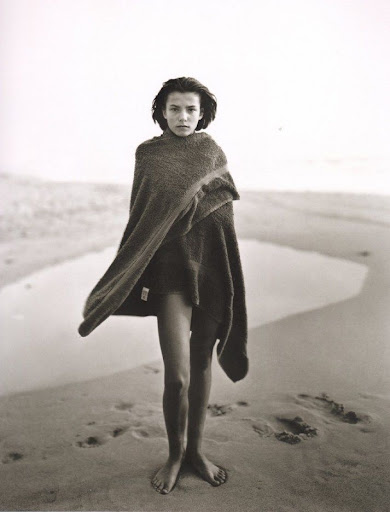
Wednesday 25 November 2009
Stephanie Imbeau
Stephanie’s artwork is the product of her exploration of community, belonging, and the role that architecture plays in contextualizing life. She is interested in how homes and the built environment affect the way people live and interact with others. Play and exploration also have significant roles in her work, as she feels that retaining a sense of child-like wonder when looking at the world is important and an effective antidote to the stresses and anxieties faced in life. The use of industrial or everyday materials is a recurring theme throughout her work, pointing at the importance, beauty and significance of daily life.
Stephanie’s work consistently manifests itself with a significant physical presence in the space it inhabits. This is not unintentional; she strives for it to be something unavoidable, and to have a dialogue with the architecture surrounding it. Regardless of the medium she uses, the location of the art informs the end result. Every space tells a story, and art can be used to unlock or add to that story.



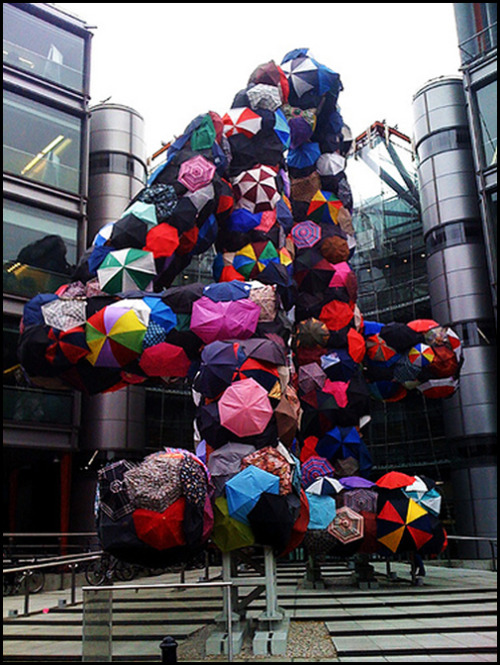
Letters to a young artists
http://www.saatchi-gallery.co.uk/blogon/art_news/letters_to_a_young_artist_mierle_laderman_ukeles/5848
The young artist asks "is it possible to maintain one's integrity and freedom of thought and still participate in the artworld?"
Dear Young Artist,
I, as you, have put off writing to you, because I am not seeing you in person to gauge your responses to what I say. Would you blink, blinking back some fear or embarrassment you might not want to expose, if I say this or that? If I were facing you, I could change my direction, make space more real or possible for you in what I say. In a letter, you are a "Young Artist" in the abstract. I am worrying about your uniqueness, about not honoring your uniqueness. Are your sensibilities rawly close to the surface or protected by a fresh urban armor? Will you have any clue what I am talking about? Can this be a good and helpful thing for you or a stumbling block? But we're stuck on paper; so here goes.
I believe that art is the articulation of human freedom. Remember, above all, you are the boss, The Boss, of your freedom. No one else. Your art, if it is original and worth something, expands all human freedom.
Art, after it comes through you, will be different. Art comes from you, you all by yourself, unique among anyone who has ever lived in the history of the world; AND, art comes from you in your world with the choices you make as a free being, and the glue, even. With the relationships that you create and stick to; AND art comes from you as a citizen in the world; AND you within history and in nature.
It is your job to re-invent art itself, through what you create.
This is not the job of critics, theorists, and curators. They follow. We lead, shape, and bend the path of history.
I'm not saying throw out history. But the main history we work from is from artist to artist: handed down. Actually, to save your neck, you can learn to talk to artists, even those from hundreds and thousands of years ago: Bring them your problems, your terrors, your dreams, practical things you have to solve.
You don't have to shape up to someone else's definition of "the artist." Make it up, make up the whole thing, while you're doing what you have to do to survive. You are even free to open yourself up to survival and maintenance of your choices as fountains of your art; you can let these tough customers flow through you.
You worry about showing too early. I disagree. Because you will change, become a new person, many many times over through the years. You will re-invent yourself out of your circumstances and your will. If you show later, you're someone else. Showing can keep a kind of integrity to who you are at the moment.
I used to worry about that when I was young. I actually thought I would keep silent for ten years before I opened my mouth about anything. Now I think that's ridiculous. I was a certain kind of spirit then, and a different one ten years later. Shmushing your young spirit into a more "mature" spirit is being violent to oneself as one is through time.
You ask about the art world and worry about it corrupting you. First of all, you only mention galleries in relation to the art world. You don't mention the streets, the water, the air, the land, below the land. You don't mention cities, urbanism. You don't mention outer space, inner space, multiple scales, microscopic scales. WHAT? You don't mention the public domain, democracy, the meaning of public.
You don't mention the people who receive or who could enter into direct relationship, even interactive relationship, with your art.
You don't mention changing the world itself, bursting all categories, starting over, re-inventing everything. WHAT?
You can see here that I come from the 1960s and 70s. It's so obvious.
So I think the "Art World" is a much more huge entity than you mention. It's way bigger than galleries.
BUT, I cherish the art world. The whole art world. It can be cruel, cold, indifferent; but it is also a world that you can shape. That's where there are people who can listen to you at the deepest level, more than anyone. People who can come across you -- even people that you may never meet -- and who will make it possible for you to keep believing in your own struggle, even if you become desperate. They are at the essence of the enterprise of making and continuing to make until you have no more breath to breathe! It is the art world that has kept art going from eons ago, responsible to art as if it were one's own child.
So I wish you a long life and great courage. Believe in yourself and work your ass off.
Mierle Laderman Ukeles
New York

Always growing
'The man who thinks he knows something does not yet know as he ought to know.'
1 Corinthians 8:2
Sunday 22 November 2009
Tomato sculpture

What a great moment it was when I found this within my stock this morning in work. Still figuring out why I found it so fascinating and beautiful, it really caught my attention. It is just a piece of black tape, paper and some tomatoes which managed to assemble themselves into this beautiful shape as they made there way from the depo into our store. Hung it up straight away in my aisle and took some pictures with my camera, also got some pictures of my work m8s and one of the sun as it was rising and piercing through the clouds. Great start to a Sunday morning :)
Thanks to the male models Johny, Davie and Broony.




